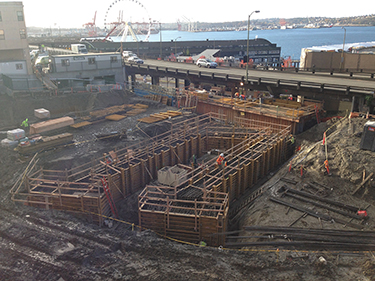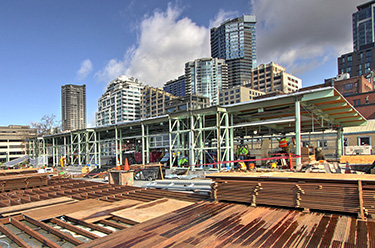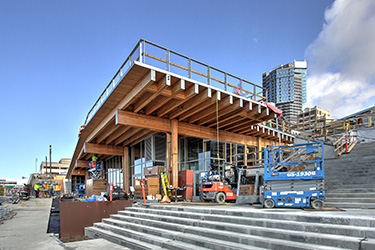|
Subscribe / Renew |
|
|
Contact Us |
|
| ► Subscribe to our Free Weekly Newsletter | |
| home | Welcome, sign in or click here to subscribe. | login |
Architecture & Engineering
| |
 |
June 29, 2017
MarketFront sits just inches above an active train tunnel: Here's how
Magnusson Klemencic Associates

Fields
|
Hidden below the dramatic Puget Sound views at the Pike Place MarketFront building is a complex structural system reflecting a daunting set of constraints imposed by the 100-plus-year use of the site, and the very diverse new building program.
Cutting diagonally through the depth of the site lies the northern extent of the Great Northern Tunnel. This vital transportation corridor carries all north-south railway cargo and passenger traffic through Seattle.
The uninterrupted operation and protection of the tunnel was paramount in the design of the MarketFront building. This 28-foot-high by 30-foot-wide tunnel was hand-dug by an army of miners in 1903 and 1904.
Ten years later, settlement of the ground surface due to decomposing formwork required the installation of a concrete “heading” along the length of the tunnel. Again, this process was completed by hand and shovel, with the heading shape dictated by the variable voids, sometimes many feet thick. The end product left great uncertainty about the exact shape and depth of the tunnel roof, eventually resolved with 32 potholes.
The MarketFront development plans required maximizing parking count. As the trapezoidal lot slopes downward to the south and west, and is slashed from below by the train tunnel, a tightly constrained prism remains in which to locate the garage program.
To fit four stories of parking within this prism, a beamless concrete slab solution was selected to minimize structural depth. This framing system requires a higher density of columns, each on its own pile-supported foundation, which in turn are carefully located to miss the tunnel and heading.
The final solution is a highly orchestrated arrangement of columns, parking stalls and drive ramps, all fundamentally dictated by the shape of the Great Northern Tunnel residing invisibly below. In places, the parking slab spans just 12 inches above the crest of the tunnel. In others, 11-foot-deep concrete girders support tower columns over the rounded edge of the heading.
Buried in a steep hillside currently hidden beside the Highway 99 viaduct, the MarketFront building is also a retaining structure.
Thirty-four feet of unbalanced soil height is trying to push the garage downslope toward Puget Sound. As a result, parking slabs and pile foundations are doing much more than holding the building up. They are an interconnected system holding back a 350-foot length of Western Avenue, resisting both the current weight of the soil and the additional mass expected to be activated during a major seismic event.
Three buildings in one
Three dramatically different building uses, with three wildly different architectural expressions, are stacked at the northern half of the MarketFront building.
Strength, stiffness and utilitarianism led the design towards concrete framing for the garage levels. Stacked upon the garage is a story of high-bay, large-volume retail space. This zone has the access, light and functionality of a modern commercial property, yet speaks in the architectural language of the older Market buildings, using heavy timber framing with steel bracing and bracket connections to give a timeless, rustic look.
Finally, the top tier of this stacked program celebrates the natural light and view from the Market, as well as the indoor/outdoor history of the market vendors.
The pavilion was originally envisioned with a retractable fabric roof. But considering the strong winds coming up from the waterfront, it was clear a more stout enclosure would be needed for this rooftop space to be utilized year-round.
Steel framing was selected to minimize member sizes and maximize the transparency of the pavilion, using narrow tubes for support and rod bracing for seismic stability. Glass-clad operable walls form the east and west sides of this vendor space, allowing for comfort even during extreme weather days in Seattle.
Capping this pavilion is a unique series of 12 pre-tensioned lenticular trusses. The consideration of both heavy downward snow loads, as well as sudden upward wind loads, require the roof to have near-equal capacity in both directions. The architectural goal for lightness and openness drove to a solution of top and bottom rod chords pre-tensioned up to 20,000 pounds each.
A bridge rehab
Following the 1974 fire and tear-down of a garage on the MarketFront site, the Joe Desimone Bridge was left as a bridge to nowhere, and converted into additional market stall space.
Although now thoroughly disguised as an enclosed building, this bridge was built in the 1960s specifically to carry cars and trucks. The Desimone Bridge is now once again a primary connection between the main Market concourse and the MarketFront property, delivering pedestrians directly to the rooftop indoor/outdoor vendor space.
Rehabilitating the bridge was not originally included in the MarketFront development plans, but the seismic vulnerability of this 50-year-old concrete structure became the focus of discussion after a routine site visit by MKA spotted a precarious state of support and interconnection.
The increased understanding of Seattle’s intense seismic environment and the advances in the field of structural engineering has led modern buildings to be much more robust than those built in the 1960s. However, unless significant modifications are implemented on an existing building there is no code requirement for those buildings to be brought up to current design standards.
After discussing the precarious state of the Desimone Bridge, the Pike Place Market Preservation and Development Authority (PDA) elected to make voluntary seismic upgrades to this out-of-date concrete structure.
New pin piles support existing columns on previously undersized footings. Encased concrete beams and columns now provide ductile lateral resistance to earthquakes. Finally, the entire assembly is firmly connected together as well as to the main Market retaining wall to provide overall stability.
The PDA acted with great foresight to upgrade this historic portion of the Market, preserving safe exiting from the Market buildings and a clear roadway below for emergency vehicles to pass in the aftermath of a major event.
David Fields is a senior principal at Magnusson Klemencic Associates.
Other Stories:
- Low-income housing joins the mix at MarketFront
- MarketFront fulfills long-held dream to reclaim site marred by fire
- New open space is the next step on a path to the waterfront
- ‘This is going to be a wild ride’ for the design team
- The story behind — and beneath — those big vent stacks





